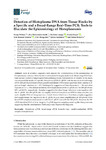Detection of Histoplasma DNA from Tissue Blocks by a Specific and a Broad-Range Real-Time PCR: Tools to Elucidate the Epidemiology of Histoplasmosis
Wilmes, Dunja
McCormick-Smith, Ilka
Lempp, Charlotte
Mayer, Ursula
Schulze, Arik Bernard
Theegarten, Dirk
Hartmann, Sylvia
Rickerts, Volker
Lack of sensitive diagnostic tests impairs the understanding of the epidemiology of histoplasmosis, a disease whose burden is estimated to be largely underrated. Broad-range PCRs have been applied to identify fungal agents from pathology blocks, but sensitivity is variable. In this study, we compared the results of a specific Histoplasma qPCR (H. qPCR) with the results of a broad-range qPCR (28S qPCR) on formalin-fixed, paraffin-embedded (FFPE) tissue specimens from patients with proven fungal infections (n = 67), histologically suggestive of histoplasmosis (n = 36) and other mycoses (n = 31). The clinical sensitivity for histoplasmosis of the H. qPCR and the 28S qPCR was 94% and 48.5%, respectively. Samples suggestive for other fungal infections were negative with the H. qPCR. The 28S qPCR did not amplify DNA of Histoplasma in FFPE in these samples, but could amplify DNA of Emergomyces (n = 1) and Paracoccidioides (n = 2) in three samples suggestive for histoplasmosis but negative in the H. qPCR. In conclusion, amplification of Histoplasma DNA from FFPE samples is more sensitive with the H. qPCR than with the 28S qPCR. However, the 28S qPCR identified DNA of other fungi in H. qPCR-negative samples presenting like histoplasmosis, suggesting that the combination of both assays may improve the diagnosis.
Dateien zu dieser Publikation

